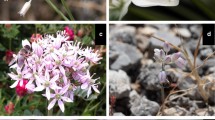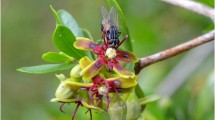Abstract
Floral odour can differ qualitatively and quantitatively between different parts of the flowers, and these spatial fragrance patterns within the flowers can be used by pollinators for orientation on flowers. Here we present results of spatial fragrance patterns within flowers of the dioecious Silene latifolia (Caryophyllaceae). Volatiles were collected and analysed using a highly sensitive dynamic headspace method, which allows dramatically reducing the sample time. From all flower parts, especially the petals and the anthophore emitted the typical flower volatiles of S. latifolia. However, compounds emitted from the petals differed from compounds emitted by the anthophore. The anthophore emitted the monoterpenoids lilac aldehydes and alcohols, whereas, all other typical scent compounds (e.g. benzoids, other monoterpenoids) were emitted by the petals. Lilac aldehydes are known to be behaviourally very attractive for noctuid moths, and they may serve as nectar guides in S. latifolia.
Similar content being viewed by others
References
R. P Adams (1995) Identification of essential oil components by gas chromatography/mass spectrometry Allured Publishing Corporation, Carol Stream Illinois
S. M Altizer P. H Thrall J Antonovics (1998) ArticleTitleVector behavior and the transmission of anther-smut infection in Silene alba Am. Midl. Nat 139 147–163
A Amirav S Dagan (1997) ArticleTitleA direct sample introduction device for mass spectrometry studies and gas chromatography mass spectrometry analyses Eur. Mass Spectrom 3 105–111
H Azuma V Rico-Gray J. G Garcia-Franco M Toyota Y Asakawa L.B Thien (2004) ArticleTitleClose relationship between Mexican and Chinese Magnolia (Subtropical disjunct of Magnoliaceae) inferred from molecular and floral scent analysis Acta Phytotax 55 167–180
G Bergström H. E. M Dobson I Groth (1995) ArticleTitleSpatial fragrance patterns within the flowers of Ranunculus acris (Ranunculaceae) Pl. Syst. Evol 195 221–242 Occurrence Handle10.1007/BF00989298
N Bolwig (1954) ArticleTitleThe role of scent as a nectar guide for honeybees on flowers and an observation on the effect of colour and recruits British J. Anim. Behav 2 81–83
S Bopp (2003) ArticleTitleParasitismus oder Symbiose? Beziehungen zwischen einem parasitischen Bestäuber (Hadena bicruris Hufn., Lepidoptera: Noctuidae) und seinen Wirtspflanzen. (Silene-Arten, Caryophyllaceae) Zoologica 152 1–140
Brantjes N. B. M. (1976a) Riddles around the pollination of Melandrium album (Mill.) Garcke (Caryophyllaceae) during the oviposition by Hadena bicruris Hufn (Noctuidae, Lepidoptera), II. Proc. Koninkl. Ned. Akad. Wetensch., Ser. C 79: 125–141.
Brantjes N. B. M. (1976b) Riddles around the pollination of Melandrium album (Mill.) Garcke (Caryophyllaceae) during the oviposition by Hadena bicruris Hufn (Noctuidae, Lepidoptera), I. Proc. Koninkl. Ned. Akad. Wetensch., Ser. C 79: 1–12.
BrantjesN.B.M.(1976c)Senses involved in the visiting of flowers byCucullia umbratica (Noctuidae, Lepidoptera). Entomol.Exp.Appl.20:1–7.
T. J Bruce A Cork (2001) ArticleTitleElectrophysiological and behavioral responses of femaleHelicoverpa armigera to compounds identified in flowers of African marigold,Tagetes erecta J. Chem. Ecol 27 1119–1131 Occurrence Handle10.1023/A:1010359811418 Occurrence Handle11504018
N. W Davies (1990) ArticleTitleGas-chromatographic retention indexes of monoterpenes and sesquiterpenes on methyl silicone and Carbowax 20M phases J. Chromatogr 503 1–24 Occurrence Handle10.1016/S0021-9673(01)81487-4
M De Bortoli H Knöppel E Pecchio H Schauenburg H Vissers (1992) ArticleTitleComparison of Tenax and Carbotrap for VOC sampling in indoor air Indoor Air 2 216–224 Occurrence Handle10.1111/j.1600-0668.1992.00004.x
H. E. M Dobson (1994) Floral volatiles in insect biology E. A. Bernays (Eds) Insect-plant interactions CRC Press London Tokyo 47–81
H. E. M Dobson G Bergström I Groth (1990) ArticleTitleDifferences in fragrance chemistry between flower parts of Rosa rugosa Thunb (Rosaceae) Isr. J. Bot 39 143–156
H. E. M Dobson I Groth G Bergström (1996) ArticleTitlePollen advertisement: Chemical contrasts between whole-flower and pollen odors Amer. J. Bot 83 877–885
Dötterl S. (2004) Importance of floral scent compounds for the interaction between Silene latifolia (Caryophyllaceae) and the nursery pollinator Hadena bicruris (Lepidoptera: Noctuidae). PhD Thesis, University of Bayreuth.
S Dötterl L. M Wolfe A Jürgens (2005) ArticleTitleQualitative and quantitative analyses of flower scent in Silene latifolia Phytochemistry 66 203–213 Occurrence Handle10.1016/j.phytochem.2004.12.002 Occurrence Handle15652577
W. N Ellis A. C Ellis-Adam (1993) ArticleTitleTo make a meadow it takes a clover and a bee: the entomophilous flora of N.W. Europe and its insects Bijdragen tot de Dierkunde 63 193–220
G Flamini P. L Cioni I Morelli (2002) ArticleTitleDifferences in the fragrances of pollen and different floral parts of male and female flowers of Laurus nobilis J. Agric. Food Chem 50 4647–4652 Occurrence Handle10.1021/jf020269x Occurrence Handle12137491
A. M Fraser W. L Mechaber J. G Hildebrand (2003) ArticleTitleElectroantennographic and behavioral responses of the sphinx mothManduca sexta to host plant headspace volatiles J. Chem. Ecol 29 1813–1833 Occurrence Handle10.1023/A:1024898127549 Occurrence Handle12956509
A Gordin A Amirav (2000) ArticleTitleSnifProbe: new method and device for vapor and gas sampling J. Chromatogr. A 903 155–172 Occurrence Handle10.1016/S0021-9673(00)00877-3 Occurrence Handle11153938
K. F Haynes J. Z Zhao A Latif (1991) ArticleTitleIdentification of floral compounds from Abelia grandiflora that stimulate upwing flight in cabbage looper moths J. Chem. Ecol 17 637–646 Occurrence Handle10.1007/BF00982132
R. R Heath P. J Landolt B Dueben B Lenczewski (1992) ArticleTitleIdentification of floral compounds of night-blooming jessamine attractive to cabbage looper moths Env. Entomol 21 854–859
A Jürgens S Dötterl (2004) ArticleTitleChemical composition of anther volatiles in Ranunculaceae: genera-specific profiles in Anemone, Aquilegia, Caltha, Pulsatilla, Ranunculus, and Trollius species Amer. J. Bot 91 1969–1980
A Jürgens T Witt G Gottsberger (1996) ArticleTitleReproduction and pollination in central European populations of Silene and Saponaria species Bot. Acta 109 316–324
A Jürgens T Witt G Gottsberger (2002) ArticleTitleFlower scent composition in night-flowering Silene species (Caryophyllaceae) Biochem. Syst. Ecol 30 383–397 Occurrence Handle10.1016/S0305-1978(01)00106-5
R Kaiser (1993) Vom Duft der Orchideen Editiones Roche Basel
J. T Knudsen L Tollsten (1991) ArticleTitleFloral scent and intrafloral scent differentiation in Monesesand Pyrola(Pyrolaceae) Pl. Syst. Evol 177 81–91 Occurrence Handle10.1007/BF00937829
J. T Knudsen L Tollsten (1993) ArticleTitleTrends in floral scent chemistry in pollination syndromes: floral scent composition in moth-pollinated taxa Bot. J. Linn. Soc 113 263–284 Occurrence Handle10.1006/bojl.1993.1073
J. T Knudsen L Tollsten L. G Bergström (1993) ArticleTitleFloral scents: A checklist of volatile compounds isolated by head-space techniques Phytochemistry 33 253–280 Occurrence Handle10.1016/0031-9422(93)85502-I
T Lex (1954) ArticleTitleDuftmale an Blüten Z. Vergl Physiol 36 212–234
R. L Meagher (2001) ArticleTitleCollection of soybean looper and other noctuids in phenylacetaldehyde-baited field traps Fla. Entomol 84 154–155
R. L Meagher (2002) ArticleTitleTrapping noctuid moths with synthetic floral volatile lures Entomol. Exp. Appl 103 219–226 Occurrence Handle10.1046/j.1570-7458.2002.00977.x
T Miyake R Yamaoka T Yahara (1998) ArticleTitleFloral scents of hawkmoth-pollinated flowers in Japan J. Plant Res 111 199–205
P. W Pare J. H Tumlinson (1999) ArticleTitlePlant volatiles as a defense against insect herbivores Pl. Physiol 121 325–331 Occurrence Handle10.1104/pp.121.2.325
E Pichersky R. A Raguso E Lewinsohn R Croteau (1994) ArticleTitleFloral scent production in Clarkia (Onagraceae): I. Localization and developmental modulation of monoterpene emission and Linalool synthase activity Pl. Physiol 106 1533–1540
D Plepys F Ibarra C Löfstedt (2002) ArticleTitleVolatiles from flowers of Platanthera bifolia (Orchidaceae) attractive to the silver Y moth, Autographa gamma (Lepidoptera: Noctuidae) Oikos 99 69–74 Occurrence Handle10.1034/j.1600-0706.2002.990107.x
R. A Raguso (2004) ArticleTitleWhy are some floral nectars scented Ecology 85 1486–1494
R. A Raguso O Pellmyr (1998) ArticleTitleDynamic headspace analysis of floral volatiles: a comparison of methods Oikos 81 238–254
R. A Raguso E Pichersky (1999) ArticleTitleA day in the life of a linalool molecule: Chemical communication in a plant-pollinator system. Part 1: Linalool biosynthesis in flowering plants Pl. Spec. Biol 14 95–120 Occurrence Handle10.1046/j.1442-1984.1999.00014.x
S. B Ramaswamy (1987) ArticleTitleBehavioral responses of Heliothis virescens (Lepidoptera: Noctuidae) to stimulation with sugars J. Insect Physiol 33 755–760 Occurrence Handle10.1016/0022-1910(87)90062-X
S Siegel N. J Castellan (1988) Nonparametric statistics for the behavioural sciences McGraw-Hill New York
StatSoft, Inc. 2003. STATISTICA for Windows Version 6.1. www.statsoft.com.
S Vogel (1963) Duftdrüsen im Dienste der Bestäubung: Űber Bau und Funktion der Osmophoren Akademie der Wissenschaften und der Literatur Mainz
S Vogel (1998) ArticleTitleRemarkable nectaries: structure, ecology, organophyletic perspectives III. Nectar ducts Flora 193 113–131
A Aufsess Particlevon (1960) ArticleTitleGeruchliche Nahorientierung der Biene bei entomophilen und ornithophilen Blüten Z. Vergl. Physiol 43 469–498 Occurrence Handle10.1007/BF00298072
Wilkinson S, Ladd P The use of a solids inlet system to identify essential oils in anthers and leaves of flowering plants. Varian GC/MS Application Note 65.
Witt T. (2003) Reproduktionsbiologie von Caryophyllaceen (Unterfamilie Caryophylloideae) unter besonderer Berücksichtigung der Nektarproduktion. Dissertation, Universität Ulm, Ulm.
H. J Young (2002) ArticleTitleDiurnal and nocturnal pollination of Silene alba (Caryophyllaceae) Amer. J. Bot 89 433–440
Author information
Authors and Affiliations
Corresponding author
Rights and permissions
About this article
Cite this article
Dötterl1, S., Jürgens, A. Spatial fragrance patterns in flowers of Silene latifolia: Lilac compounds as olfactory nectar guides?. Plant Syst. Evol. 255, 99–109 (2005). https://doi.org/10.1007/s00606-005-0344-2
Received:
Accepted:
Published:
Issue Date:
DOI: https://doi.org/10.1007/s00606-005-0344-2




